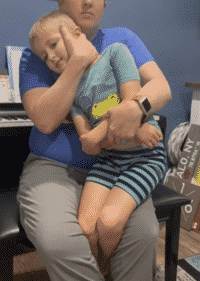Please note, at Hand in Hand Parenting we respect your choices as a caregiver. Vaccinations are a highly personal choice that only you can make with your family, and this post is not intended to support or dissuade a decision to vaccinate. This post shares ideas for those who have decided to proceed and who want connecting ways to help handle a child’s fears around the process. Many of the ideas shared here work equally well for minor medical checks and procedures, like ear exams and blood tests.
How can I support my child getting vaccines?
Do you have a child who is terrified of medical procedures like getting vaccines?
Do you dread the crying, wriggling, and guilt associated with the process?
Are you emotionally drained afterwards, and have mixed feelings about the whole thing?
These concerns are common among many parents, particularly in the middle of a global pandemic where medical checks and vaccinations are on the rise. The added fatigue and demands caused by living in the pandemic may also make handling these issues even more pressured and stressful.
Many children struggle with the idea of getting vaccines, blood tests and other minor procedures even when they are conscious that it may offer protection or recovery.
Fear is a driving factor.
Replacing fear with confidence
You’ve probably felt it yourself. Fear is in the air as the pandemic continues to morph and evolve. We all feel it. It shows up in resistance to things we might usually find easy, like getting outside or going to the jungle gym. It appears as we battle our feelings about yet another Zoom session. When another potentially scary situation, like a vaccine, pops up the ongoing sense of perceived threat can kick in, sending us straight to fight or flight mode.
It's a lot for families to deal with.
Supporting your child ahead of time
How can you avoid the wriggling, the crying and resistance in the doctor’s office or hospital?
As a Hand in Hand Parenting Certified Instructor, I know that some of the most powerful antidotes to fear are connection and play.
I know… I know… This idea may go against your first instincts, particularly with something like vaccines. As parents, we often feel we just have to fumble through and get it done.
But when we work with our children through their fear ahead of time, it can be overcome. Even more reassuring is that through this process, the child accesses greater empowerment and confidence that they carry with them into the future.
Start by building a team mentality with your child
Often in life, children can feel that it's “us” versus “them”, so a good place to start is by showing them that you are on their side when it comes to getting the shot. Building a team mentality with your child allows you space to hold the limit you have around getting the shot, while also listening to and supporting the feelings your child has about the decision.
This is much more than simply getting them “on side.”
You can simply state when you will schedule the vaccine and then meet your child where they are. You’ll get a good read of where their fear level is by watching their response. Some children may be able to move into a light discussion on what to expect during the appointment, and you’ll be able to answer any questions they have.
Other children may need to resist the idea at first.
Why this response can often look like defiance
Children may cry, stamp their feet, meltdown or beg not to have a shot. This may look like defiance, but is a clear way for your child to show the fear they have about the process and is a healthy start to processing and releasing their feelings. You can read more about how new experiences can trigger past fears for a child in this post, Helping Children Conquer Their Fears.
Allowing these feelings and holding space for them allows the child to work through them while feeling safe. Hand in Hand Parenting calls this Staylistening.
It's a simple idea that involves us as the parent listening to a child’s big feelings, such as crying, tantrums, and yelling, without jumping in to fix or problem-solve, and without reasoning or lectures.
When you stay quiet, close and focused on giving the child your love and acceptance, they can offload the difficult feelings and co-regulate with you. Your child tunes into your calm and your belief that all will be well. Read more about the brain’s response to overwhelming feelings.
Making a plan for vaccination day
You will see that after one or a few sessions of offloading like this, your child may be willing and able to move into more of a planning mode.
- Maybe you can talk about what they want you to do at the doctor’s office.
- Would they like you to hold them on your lap?
- Just hold their hand?
- Stand next to them?
Wondering what to do if they do ask you to hold them? This is how @drbeachgem10, a pediatrician and mom of four, recommends holding a child for a vaccine:

For a younger child who might fight this hold, try having them on your lap facing you, with their legs wrapped around your waist. Holding their head against your chest and keeping your chin on top of their head avoids any head butting.
With younger children you can demonstrate at home how you will hold them and help them get comfortable in the position, so it doesn't feel restrictive at the doctor’s office.
You can also use these moments to remind them that you will keep them safe while the doctor does their thing.
Preparing like this restores a little of your child’s sense of control.
This helps loosen a child’s fear of vaccines
Once you’ve established that you are there to be on their side during this hard thing, you can begin to use play to loosen fear.
Laughter releases fears, and you can set up play to shift fears around specific situations. We call this Playlistening. During this play, take the less powerful role, and let your child boast and revel in their power over you. Look for laughter as your clue that the play is going well, and isn’t threatening or too scary. The longer you can play in this way, the bolder your child will become.
Yes, you can play with the idea of getting shots
Some ideas geared towards a fear of vaccines include (but are not limited to):
- You as the parent taking the victim role of the patient and your child being the doctor or nurse who gets to give you vaccines over and over and over. Squeal in fear and beg them not to do it every time they try. (You might be surprised with the ways they try to offer you comfort and this can give insight into how they want to be comforted).
- Having your child and another adult they trust gang up on you and chase you around with toy needles. Follow those giggles. This type of play can really loosen things up for kids and adults alike.
- Give the “needle” different personality traits. Seen Forky in Toy Story? Give your toy needle a name and a personality too. Here’s a few ideas to try:
- Scared needle too afraid to give someone a shot because they will cry
- Baby needle who doesn't know what to do and must be shown their job
- Wobbly needle who just can't seem to hold still long enough to give a shot
- Silly needle keeps doing it wrong and must be corrected
Sometimes laughter can turn to tears and then back to laughter, this is okay. In fact, you may find that in the time leading up to the doctor’s appointment, your child circles through resistance and crying, playing and talking.
This is the natural way that humans offload fears and gain strength, one small chunk at a time.
Follow your child's lead. They will know what to do when you give them the time and space to figure it out.
Increase connection as vaccine day draws close
When the event draws near, make sure to focus on building warmth and connection.
My favorite way to do this is through more one-on-one time, or Special time as we call it at Hand in Hand Parenting. Watch Hand in Hand Parenting’s founder Patty Wipfler explain how to do Special Time here.
This beautifully connecting activity will support your child well as they prepare themselves for vaccine day. If you already do regular Special Time, try upping the amount of time you do for an extra boost. If you are new to Special Time, be as consistent as you can in the weeks prior to the event.
You can get a free guide to Special Time here.
If you know the event will still be hard for everyone and you are familiar with Listening Partnerships then this is a great place to work on your own concerns and anxieties. When you can relieve some of your own tension you’ll have more capacity to listen to your child during their hard moments.
Plan for feelings on the actual day
Depending on your child's level of fear, you may choose to spend several days, or even weeks in preparation, using the ideas explained here. Even then, you can expect that your child still might be fearful or tearful about the experience up to the moment itself. This is quite normal and does not mean you didn't do a good job helping them. Feelings are natural and bound to come up, and in the long-term this work will positively impact your child, increasing their confidence and resilience.
On the day, roleplay the plan you came up with together. Listen to any feelings that remain and remind your child that you are in the experience together and that you will keep them safe.
If you can connect with your healthcare provider beforehand, explain that you would like to not be rushed and to be allowed ample time for your child to work on their feelings. If that's not possible, try to arrive 30 minutes or so early to the appointment, so that when your child has feelings, whether in the car, in the parking lot or in the waiting room, there is plenty of time for them to be held and seen before you move forward with your plan.
Providing space to recover
Some children will seem to take the vaccination in their stride, and recover easily. Others might clearly show that they carry some big feelings afterwards. You may notice whining or rigidity. Your child may make connection bids (which can look, confusingly, like attention-seeking behavior). This is a sign they could use a little extra space to work through their feelings.
Making time for Special Time, rough and tumble play, and Playlistening provides a safe landing space for your child to do this with you. These activities restore a strong sense of connection and safety as your child offloads any remaining fears.
Reading where you are in the cycle…
As you can see, shedding fear can be a slow process. It is often cyclical. Using all the tools mentioned here helps provide your child all they need to offload their worries and anxieties through laughter, play, tears and upsets. Make regular moments in your schedule to connect and listen, and you will see exactly where your child needs to be. If they still dig their heels in on the eighth mention about vaccines, try leaning into play. If that play ends in tears, trust them in their process.
Many children are fearful about a visit to the doctor. These ideas address those underlying fears. Use them liberally, with warmth and as much openness as you can muster. You will see your child’s trust in you, as their supporter and partner grow, and their ability to offload their fear will increase.
Remember that resistance, whining, tantrums and tearful moments signal there is some more offloading to be done, and that your child is working hard on showing you the emotional block of fear they hold. You, as the parent, are doing remarkable things to hold that space.
If your child is scared to get shots, try these ideas to help them overcome their fears:
- Take away “us versus them”. Establish a “team mentality” where you are all on the same side.
- Make a plan that they are comfortable with, and note where your child feels resistant or upset.
- Listen to their upset, and hold space, knowing that they are working on a chunk of fear. No need to fix things, reason, lecture or offer solutions.
- Use play to help loosen worry and anxiety. Follow their lead and look for giggles.
- As the day draws close, front load with a bigger focus on connection
- Revisit your plan, and roleplay it.
- Hold the limit when the time comes, even if there are tears involved.
- Make time for healing connection, laughter, and play afterwards.

